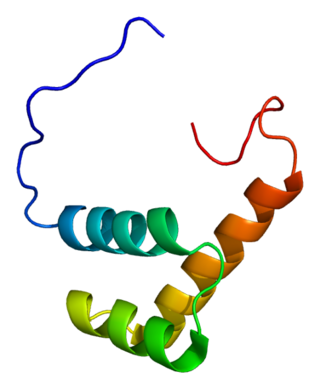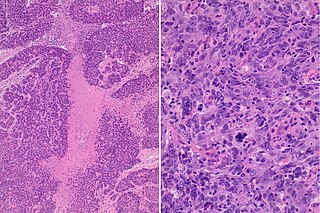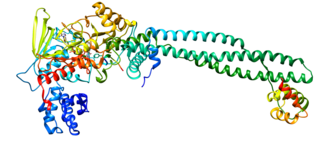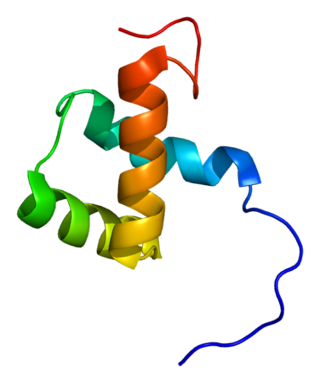Zinc finger protein SNAI2 is a transcription factor that in humans is encoded by the SNAI2 gene. It promotes the differentiation and migration of certain cells and has roles in initiating gastrulation. [5] [6] [7]
Zinc finger protein SNAI2 is a transcription factor that in humans is encoded by the SNAI2 gene. It promotes the differentiation and migration of certain cells and has roles in initiating gastrulation. [5] [6] [7]
This gene encodes a member of the Snail superfamily of C2H2-type zinc finger transcription factors. The encoded protein acts as a transcriptional repressor that binds to E-box motifs and is also likely to repress E-cadherin transcription in breast carcinoma. This protein is involved in epithelial-mesenchymal transitions and has antiapoptotic activity. It regulates differentiation and migration of neural crest cells along with other genes (e.g. FOXD3, SOX9 and SOX10, BMPs) in embryonic life. Mutations in this gene may be associated with sporadic cases of neural tube defects. [7] [8]
SNAI2 downregulates expression of E-cadherin in premigratory neural crest cells; thus, SNAI2 induces tightly bound epithelial cells to break into a loose mesenchymal phenotype, allowing gastrulation of mesoderm in the developing embryo. [9] [10] Structurally similar to anti-apoptotic Ces-1 in C. elegans, SLUG is a negative regulator of productive cell death in the developing embryo and adults. [9] [11]
Widely expressed in human tissues, SLUG is most notably absent in peripheral blood leukocytes, adult liver, and both fetal and adult brain tissues. [11] SLUG plays a role in breast carcinoma as well as leukemia by downregulation of E-cadherin, which supports mesenchymal phenotype by shifting expression from a Type I to Type II cadherin profile. [11] [12] Maintenance of mesenchymal phenotype enables metastasis of tumor cells, though SLUG is expressed in carcinomas regardless to invasiveness. [9] [10] [11] A knockout model using chick embryos has also showed inhibition of mesodermal and neural crest delamination; chick embryo Slug gain of function appears to increase neural crest production. [9] Mutations in Slug are associated with loss of pregnancy during gastrulation in some animals. [9]
Bone morphogenetic proteins (BMPs) precede expression of SLUG and are suspected as the immediate upstream inducers of gene expression. [10] [13]

Cadherins (named for "calcium-dependent adhesion") are cell adhesion molecules important in forming adherens junctions that let cells adhere to each other. Cadherins are a class of type-1 transmembrane proteins, and they depend on calcium (Ca2+) ions to function, hence their name. Cell-cell adhesion is mediated by extracellular cadherin domains, whereas the intracellular cytoplasmic tail associates with numerous adaptors and signaling proteins, collectively referred to as the cadherin adhesome.

Neural crest cells are a temporary group of cells that arise from the embryonic ectoderm germ layer, and in turn give rise to a diverse cell lineage—including melanocytes, craniofacial cartilage and bone, smooth muscle, peripheral and enteric neurons and glia.
The epithelial–mesenchymal transition (EMT) is a process by which epithelial cells lose their cell polarity and cell–cell adhesion, and gain migratory and invasive properties to become mesenchymal stem cells; these are multipotent stromal cells that can differentiate into a variety of cell types. EMT is essential for numerous developmental processes including mesoderm formation and neural tube formation. EMT has also been shown to occur in wound healing, in organ fibrosis and in the initiation of metastasis in cancer progression.

Zinc finger protein GLI2 also known as GLI family zinc finger 2 is a protein that in humans is encoded by the GLI2 gene. The protein encoded by this gene is a transcription factor.
In molecular genetics, the Krüppel-like family of transcription factors (KLFs) are a set of eukaryotic C2H2 zinc finger DNA-binding proteins that regulate gene expression. This family has been expanded to also include the Sp transcription factor and related proteins, forming the Sp/KLF family.

Krüppel is a gap gene in Drosophila melanogaster, located on the 2R chromosome, which encodes a zinc finger C2H2 transcription factor. Gap genes work together to establish the anterior-posterior segment patterning of the insect through regulation of the transcription factor encoding pair rule genes. These genes in turn regulate segment polarity genes. Krüppel means "cripple" in German, named for the crippled appearance of mutant larvae, who have failed to develop proper thoracic and anterior segments in the abdominal region. Mutants can also have abdominal mirror duplications.

Mesenchyme is a type of loosely organized animal embryonic connective tissue of undifferentiated cells that give rise to most tissues, such as skin, blood or bone. The interactions between mesenchyme and epithelium help to form nearly every organ in the developing embryo.

Twist-related protein 1 (TWIST1) also known as class A basic helix–loop–helix protein 38 (bHLHa38) is a basic helix-loop-helix transcription factor that in humans is encoded by the TWIST1 gene.

Zinc finger E-box-binding homeobox 2 is a protein that in humans is encoded by the ZEB2 gene. The ZEB2 protein is a transcription factor that plays a role in the transforming growth factor β (TGFβ) signaling pathways that are essential during early fetal development.

Early growth response protein 2 is a protein that in humans is encoded by the EGR2 gene. EGR2 is a transcription regulatory factor, containing three zinc finger DNA-binding sites, and is highly expressed in a population of migrating neural crest cells. It is later expressed in the neural crest derived cells of the cranial ganglion. The protein encoded by Krox20 contains two cys2his2-type zinc fingers. Krox20 gene expression is restricted to the early hindbrain development. It is evolutionarily conserved in vertebrates, humans, mice, chicks, and zebra fish. In addition, the amino acid sequence and most aspects of the embryonic gene pattern is conserved among vertebrates, further implicating its role in hindbrain development. When the Krox20 is deleted in mice, the protein coding ability of the Krox20 gene is diminished. These mice are unable to survive after birth and exhibit major hindbrain defects. These defects include but are not limited to defects in formation of cranial sensory ganglia, partial fusion of the trigeminal nerve (V) with the facial (VII) and auditory (VII) nerves, the proximal nerve roots coming off of these ganglia were disorganized and intertwined among one another as they entered the brainstem, and there was fusion of the glossopharyngeal (IX) nerve complex.

The basal-like carcinoma is a recently proposed subtype of breast cancer defined by its gene expression and protein expression profile.

Homeobox protein MSX-2 is a protein that in humans is encoded by the MSX2 gene.

Zinc finger protein SNAI1 is a protein that in humans is encoded by the SNAI1 gene. Snail is a family of transcription factors that promote the repression of the adhesion molecule E-cadherin to regulate epithelial to mesenchymal transition (EMT) during embryonic development.

Zinc finger E-box-binding homeobox 1 is a protein that in humans is encoded by the ZEB1 gene.

Zinc finger protein 148 is a protein that in humans is encoded by the ZNF148 gene.

Zinc finger protein 238 is a zinc finger containing transcription factor that in humans is encoded by the ZNF238 gene.

Cadherin-1 or Epithelial cadherin(E-cadherin), is a protein that in humans is encoded by the CDH1 gene. Mutations are correlated with gastric, breast, colorectal, thyroid, and ovarian cancers. CDH1 has also been designated as CD324. It is a tumor suppressor gene.

Homeobox protein goosecoid(GSC) is a homeobox protein that is encoded in humans by the GSC gene. Like other homeobox proteins, goosecoid functions as a transcription factor involved in morphogenesis. In Xenopus, GSC is thought to play a crucial role in the phenomenon of the Spemann-Mangold organizer. Through lineage tracing and timelapse microscopy, the effects of GSC on neighboring cell fates could be observed. In an experiment that injected cells with GSC and observed the effects of uninjected cells, GSC recruited neighboring uninjected cells in the dorsal blastopore lip of the Xenopus gastrula to form a twinned dorsal axis, suggesting that the goosecoid protein plays a role in the regulation and migration of cells during gastrulation.

Homeobox protein GBX-2 is a protein that in humans is encoded by the GBX2 gene.

Waardenburg syndrome type 2D, a subtype of the Waardenburg syndrome, is a rare congenital disorder caused by a mutation in the SLUG (SNAI2) gene. It is characterized by the lack of pigmentation in the skin, hair, and eyes as well as the abnormalities in the outer wall of the cochlea. This subtype lacks the wide distance between the eyes, known as dystopia canthorum, that is observed in most patients with Waardenburg syndrome. Those affected, exhibit varying degrees of deafness or complete hearing loss along with heterochromia and reports of early graying. This disease is observed in the neonatal stages of early life.